Have you ever wondered, how can I audit my website for SEO? Or, what are the activities performed during a technical SEO audit?
Well, you’re not alone. While the experts say SEO audits are critical components of any successful SEO strategy, many bloggers and website owners shy away from them. This is because they are complex, overwhelming, and intimidating.
I know this because I was in that same boat until recently. As a blogger and content strategist, I avoided everything about SEO audits for years. At first, I tried learning how to do it by reading different articles on how to conduct a technical SEO audit. But everything was just too technical for me. And so, I gave up and focused my energy on creating great content thinking that would be enough. But that was playing the ostrich!
Good content has its place, but maintaining a robust online presence requires more than just great content. Beyond good content, you need regular audits to ensure your site is healthy, optimized, and performing at its peak.
It wasn’t until I started using Rank Math, a couple of years ago, that I discovered that SEO audit doesn’t have to be overwhelming and frustrating. This is because Rank Math is equipped with a suite of SEO audit tools that make technical audits seamless.
In this post, I’ll share with you my step-by-step process for performing technical SEO audits using Rank Math. You’ll learn everything you need to know to undertake a successful SEO audit confidently and seamlessly.
So, if you’re ready, then let’s jump in!
Key Takeaways:
- Technical SEO audits help search engines understand and index your website more effectively.
- Rank Math is a comprehensive tool for SEO audits, it can be used to identify and address technical SEO issues.
- Rank Math stands out for its ease of use, detailed reporting, and unique features compared to other tools.
- Regular technical SEO audits are crucial for identifying and fixing issues that affect search engine performance and user experience.
DISCLOSURE: WebIncomeJournal is supported by readers like yourself. We may earn an affiliate commission when you purchase through our links, which enables us to offer our content for free. Learn more here.
What is a Technical SEO Audit?

Before we dive into the nitty-gritty of my step-by-step guide, let’s first understand some fundamentals about SEO audits.
A technical SEO audit is a systematic process that scrutinizes the technical aspects of a website, such as its HTML code, server response times, site architecture, and crawlability. It involves evaluating your website against a checklist of factors that search engines consider when ranking websites.
The primary goal is to uncover and address potential roadblocks that could be preventing search engines from effectively crawling, indexing, and ranking the website’s pages.
Why Perform a Technical Audit of Your Site?
As a blogger or website owner, you must regularly audit your blog or site. Such regular audits are crucial to ensuring that your site maintains its health and performance over time. Here are some of the benefits:
- Maintain Search Engine Ranking: Proactively resolving technical problems can help prevent ranking drops and ensure a website’s content remains easily accessible to search engines.
- Stay Ahead of Algorithm Updates: Search engines continually refine their algorithms, often emphasizing technical factors like site speed and mobile-friendliness. Regular audits allow websites to adapt to these changes promptly.
- Identify Emerging Issues Early: Technical audits can uncover new issues introduced by site updates, plugin changes, or external factors, enabling swift resolution before they escalate into larger problems.
- Improved Search Engine Visibility: Resolving technical issues can enhance a website’s ability to be crawled and indexed by search engines, ultimately boosting its visibility in search results.
- Increased Organic Traffic: By optimizing technical factors, a website becomes more accessible and user-friendly, attracting higher levels of organic traffic from search engines.
- Better User Experience: Technical SEO audits often identify elements that negatively impact page load times, mobile responsiveness, and overall site performance, which directly contribute to a better user experience.
Related: Master SERP Monitoring for SEO Success with Rank Math Pro
What Is Included in an SEO Audit?

A comprehensive audit could be multi-faceted, covering different aspects of a website’s architecture, code, and performance. However, the core components you should focus on are:
1. Crawling and Indexing: Search engine crawlers are the digital spiders that discover and index your website’s content. During your audit you should assess:
- Crawl Errors: Identify and resolve any crawl errors, such as server errors, blocked resources, or robot.txt misconfigurations that could be preventing search engines from accessing your site’s content.
- Indexation Issues: Analyze your website’s indexation levels and address any factors that may be hindering search engines from properly indexing your pages, such as duplicate content or orphaned pages.
2. Site Structure and Navigation: A well-organized site structure and intuitive navigation are essential for both search engines and users. During a technical audit, you should check for:
- Information Architecture: Evaluate your website’s overall information architecture, ensuring that pages are logically organized and easy to navigate.
- Internal Linking: Assess the quality and consistency of your internal linking structure, as this helps search engines understand the relationships between your pages and distribute PageRank accordingly.
3. URL Optimization: Optimized URLs play a crucial role in both search engine visibility and user experience. During your audit, you should focus on:
- URL Structure: Analyze your website’s URL structure for clarity, consistency, and keyword relevance, as well as potential issues like duplicate URLs or excessive URL parameters.
- Redirects: Identify and resolve any broken or improper redirects that could be creating a poor user experience or diluting link equity.
4. Page Speed and Performance: Site speed and performance are critical factors that impact both search rankings and user engagement. During a technical audit, you should check:
- Load Times: Measure and optimize your website’s page load times, aiming for a fast and seamless experience across different devices and connection speeds.
- Resource Optimization: Evaluate the efficiency of your website’s resources, such as images, scripts, and stylesheets, and implement optimization techniques like compression, minification, and leveraging browser caching.
5. Mobile Usability: With the ever-increasing number of mobile users, ensuring a seamless mobile experience is crucial. You should assess:
- Mobile-Friendliness: Evaluate your website’s mobile-friendliness by testing its responsiveness, user experience, and adherence to Google’s mobile-friendly guidelines.
- Accelerated Mobile Pages (AMP): Consider implementing AMP for specific content types to provide a lightning-fast mobile experience and potential ranking boost.
6. Schema Markup and Rich Snippets: Structured data and schema markup can enhance your search engine visibility and click-through rates. During a technical audit, you should assess:
- Schema Implementation: Analyze your website’s schema markup implementation, ensuring that it adheres to the latest standards and best practices.
- Rich Snippet Opportunities: Identify opportunities to leverage rich snippets, such as product reviews, event listings, or recipe markup, to stand out in search results.
7. Structured Data Analysis: Beyond schema markup, a technical SEO audit should also evaluate the overall quality and consistency of your website’s structured data. This includes:
- Structured Data Validation: Ensure that your structured data is properly formatted and compliant with search engine guidelines, using tools like Google’s Structured Data Testing Tool.
- Data Consistency: Analyze the consistency of your structured data across different pages and sections of your website, addressing any discrepancies or inconsistencies.
8. XML Sitemaps: XML sitemaps act as roadmaps for search engines, helping them discover and index your website’s content more efficiently. In your technical audit, you should check:
- Sitemap Validation: Ensure that your XML sitemaps are properly formatted, up-to-date, and free from any errors or warnings.
- Sitemap Submission: Verify that your sitemaps are successfully submitted to search engines like Google and Bing, enabling them to crawl and index your content more effectively.
9. Robots.txt and .htaccess Optimization: The robots.txt file and .htaccess (for Apache servers) control how search engines access and interact with your website. During the audit, ensure:
- Robots.txt Audit: Review your robots.txt file to ensure that it is properly configured and not inadvertently blocking important pages or resources from search engine crawlers.
- .htaccess Optimization: Analyze and optimize your .htaccess file to improve server performance, handle redirects, and enhance security.
By thoroughly evaluating these core components, you’ll gain a comprehensive understanding of your website’s technical SEO health and identify areas for improvement.
Recommended: 10+ On-Page SEO Optimization Techniques Top Bloggers Swear By
Why Use Rank Math for Technical SEO Audits?

While there are various SEO tools available in the market, I’ve found Rank Math to be exceptionally useful. Like I mentioned earlier, it was not until I started using Rank Math that technical SEO audits became a “normal” in my content marketing strategy.
Rank Math is packed with a robust set of features that make it easy for any webmaster of whatever level to identify and resolve potential technical SEO issues with ease. These features include:
- SEO Analysis Tool: Provides detailed SEO analysis and suggestions for improvement.
- Crawl Error Detection: Identifies and reports crawl errors to ensure proper indexing.
- Sitemap Generation: Automatically generates XML sitemaps to help search engines crawl your site effectively.
- Robots.txt Optimization: Allows easy editing of the robots.txt file to control search engine crawling.
- Broken Link Checker: Identifies broken links that can harm user experience and SEO.
- Page Speed Optimization: Offers insights and recommendations to improve page load times.
- Mobile-Friendly SEO: Checks for mobile usability issues and provides solutions.
- Structured Data Markup: Simplifies the implementation of schema markup for enhanced search visibility.
- URL Structure Optimization: Helps create and maintain SEO-friendly URLs.
- Canonical Tags and Hreflang Tags: Ensures correct implementation to avoid duplicate content and handle multilingual sites.
Related: Top 7 Rank Math Features to Boost Content Rankings in 2024 and Beyond (Free & Paid)
Comparison with Other Popular SEO Tools
Compared to other popular (and more expensive) SEO tools like Yoast SEO, Ahrefs, SEMrush, Moz, and Screaming Frog, Rank Math offers a more robust set of technical SEO capabilities right out of the box. Here are some of its unique features that makes it stand out:
| Feature | Rank Math | Yoast SEO | Ahrefs | SEMrush | Moz | Screaming Frog |
| Crawl Error Detection | ✅ | ❌ | ✅ | ✅ | ✅ | ✅ |
| Sitemap Generation | ✅ | ✅ | ❌ | ❌ | ❌ | ❌ |
| Robots.txt Optimization | ✅ | ✅ | ❌ | ❌ | ❌ | ❌ |
| Broken Link Checker | ✅ | ❌ | ✅ | ✅ | ✅ | ✅ |
| Page Speed Optimization | ✅ | ❌ | ✅ | ✅ | ❌ | ❌ |
| Mobile-Friendly SEO | ✅ | ❌ | ✅ | ✅ | ❌ | ❌ |
| Structured Data Markup | ✅ | ✅ | ❌ | ❌ | ❌ | ❌ |
| URL Structure Optimization | ✅ | ✅ | ❌ | ❌ | ❌ | ❌ |
| Canonical Tags | ✅ | ✅ | ❌ | ❌ | ❌ | ❌ |
| Hreflang Tags | ✅ | ✅ | ❌ | ❌ | ❌ | ❌ |
Apart from the above, Rank Math also offer a more user-friendly interface and detailed reporting compared to tools like Screaming Frog.
Benefits of Using Rank Math for SEO Audits

Using Rank Math comes with several benefits:
- Streamlined Workflow: With its intuitive interface and seamless integration with WordPress, Rank Math simplifies the SEO audit process, allowing for a more efficient and streamlined workflow.
- Comprehensive Reporting: Rank Math provides detailed reports of your SEO audits, helping you understand the health of your website and areas that need improvement.
- Automated Suggestions: The plugin provides actionable suggestions and recommendations to address identified issues, making it easier to prioritize and tackle technical SEO tasks.
- Time-saving Automation: Rank Math automates many technical SEO tasks, such as site audits, sitemap generation, and schema markup implementation, saving valuable time and resources.
- Integrated Tools: Rank Math integrates seamlessly with Google Search Console, providing enhanced data insights. It also supports integration with tools like Google PageSpeed Insights and Google Mobile-Friendly Test for thorough performance analysis.
- Ongoing Optimization: Rank Math’s regular updates ensure that your website stays compliant with the latest search engine guidelines and best practices, helping maintain optimal visibility
That being said, let’s now explore how you can audit your sites using Rank Math.
Conducting an SEO Audit Using Rank Math
Here’s a step-by-step guide on how to do a technical SEO audit using Rank Math
Step 1: Install and Setup Rank Math
Before embarking on a comprehensive SEO audit, you need to ensure that Rank Math is properly installed and configured on your WordPress website. Follow these steps to get started:
1. Install and Activate Rank Math
This is straightforward. Log in to your WordPress dashboard and navigate to Plugins > Add New. Search for “Rank Math” and locate the plugin developed by Rank Math. Click the “Install Now” button, and once the installation is complete, click “Activate.”
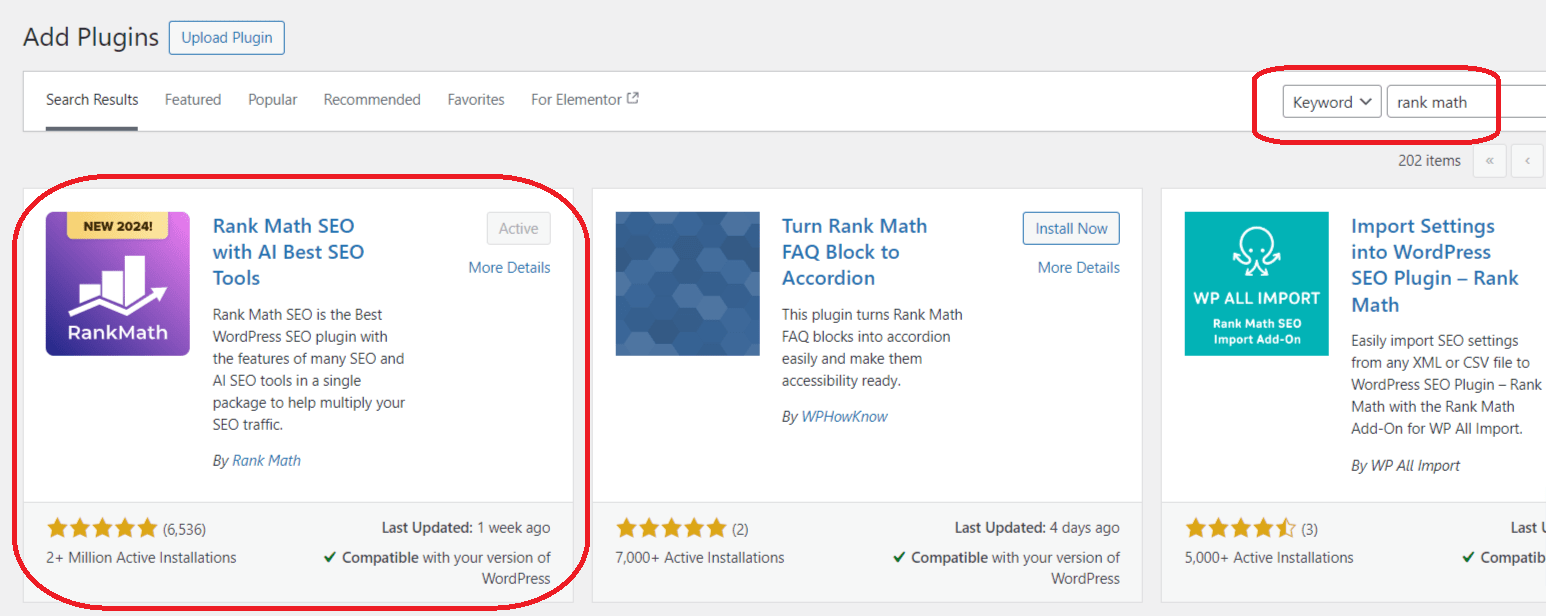
2. Configure Rank Math Settings
With Rank Math installed and activated, you’ll need to configure the essential settings to ensure that all necessary tools and features are enabled. To do this, navigate to Rank Math > Dashboard > Setup Wizard and follow the setup wizard.
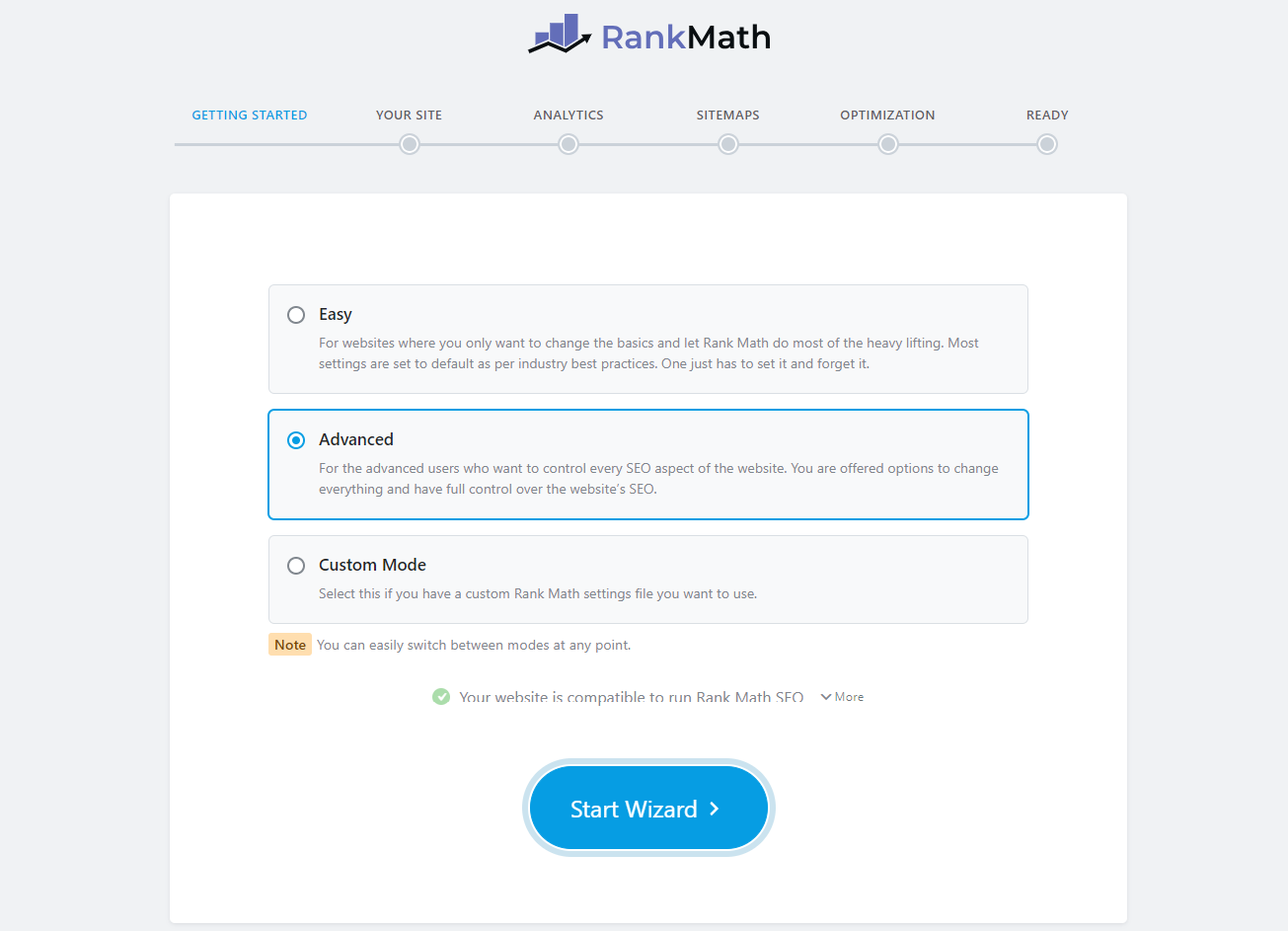
During the setup process, you’ll be prompted to connect your Google Search Console account. Connecting your account will provide Rank Math with valuable data insights, enabling more comprehensive analysis and recommendations.
Enable Critical Options
After completing the setup wizard, navigate to Rank Math > Dashboard > Modules and ensure that the following critical options are enabled:
SEO Analyzer: This feature will analyze your website’s content and provide recommendations for improving on-page SEO, including technical aspects such as schema markup and structured data.
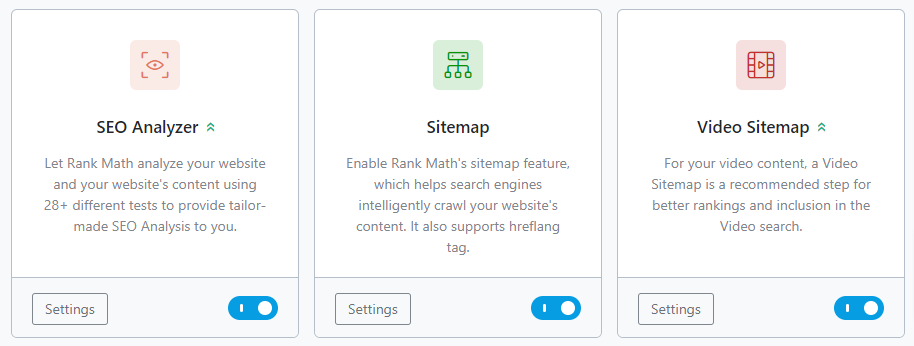
404 Monitor: Enabling this option will allow Rank Math to track and report 404 errors, crucial for identifying and fixing broken links during your audit.
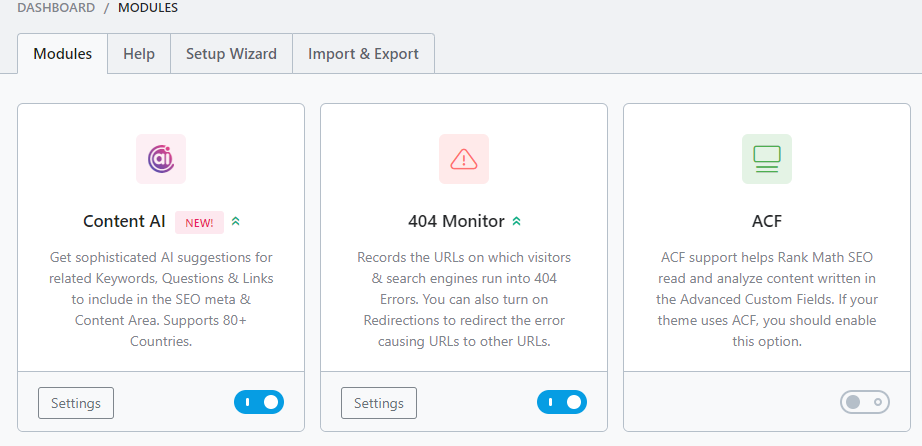
Additionally, explore the other settings within the General Settings tab and configure them according to your website’s needs and preferences.
Set Up XML Sitemaps
XML sitemaps are essential for helping search engines efficiently crawl and index your website’s content. To set up XML sitemaps with Rank Math, follow these steps:
- Ensure that the Sitemap option is enabled via Rank Math > Dashboard > Modules
- After this, navigate to Rank Math > Sitemap Settings
- Customize the sitemap settings according to your preferences, such as specifying the frequency of updates and the number of URLs to include per sitemap file.
- Once configured, you can submit your sitemap to major search engines like Google and Bing through their respective webmaster tools.
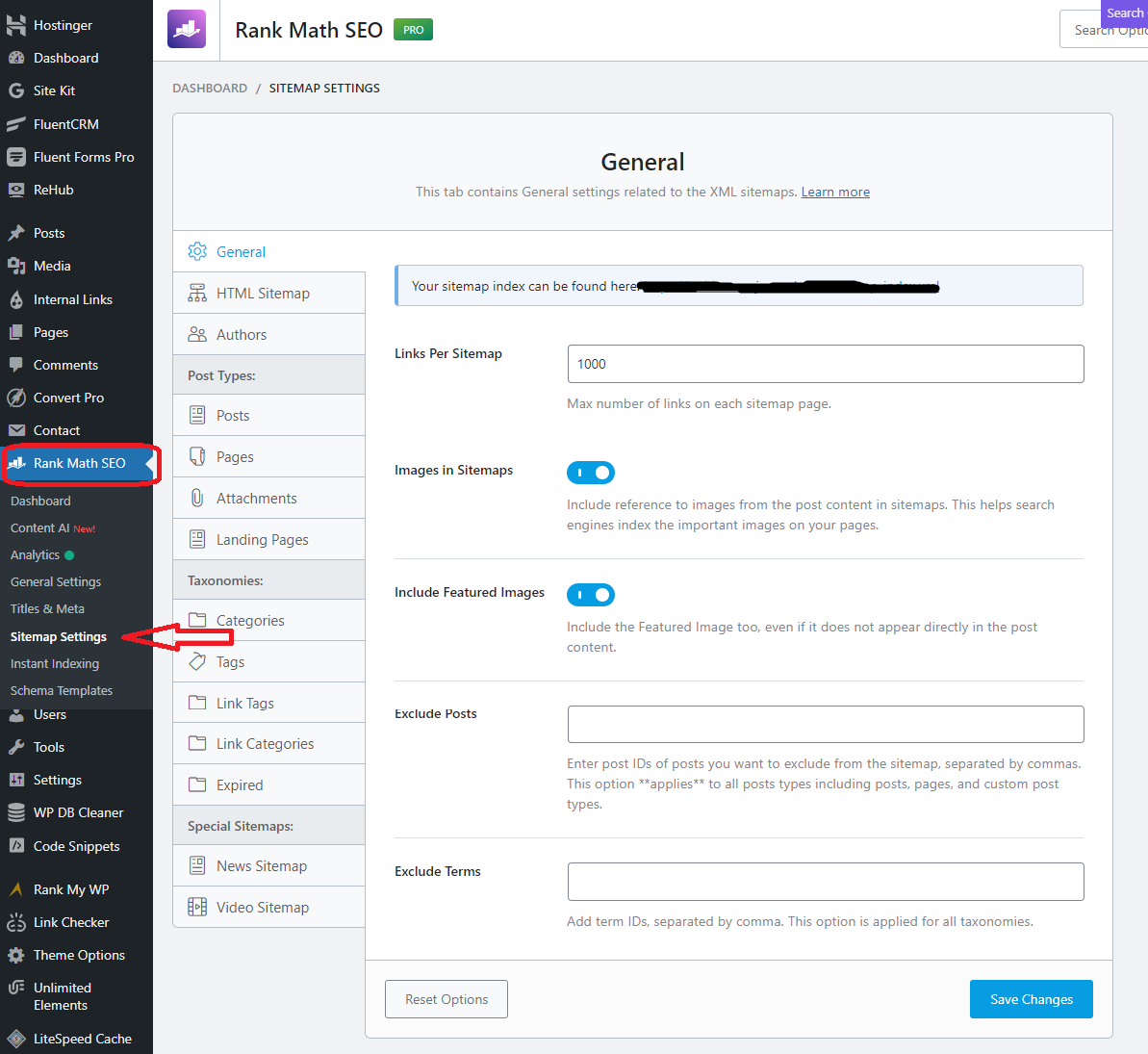
By properly installing, activating, and configuring Rank Math, you’ll have a powerful suite of tools at your disposal, enabling you to conduct a comprehensive SEO audit and identify hidden issues that may be impacting your website’s search engine visibility and performance.
Recommended: SEO Course by Rank Math: Unleash Your SEO Expertise in 2024 and Beyond!
Step 2: Crawl and Analysis Your Site with Rank Math
After installing Rank Math, the next step is to perform a thorough crawl of your website to identify potential issues. With Rank Math, this process is streamlined and easy to execute:
- Run a Site Audit: From the Rank Math dashboard, navigate to “Site Analyzer” and click the “Run Test” button. This will initiate a complete crawl of your website.
- Monitor Progress: Rank Math will display the crawl progress, allowing you to track the number of pages and resources being analyzed.
- Review Audit Report: Once the crawl is complete, Rank Math will generate a detailed report highlighting any technical SEO issues found on your site.
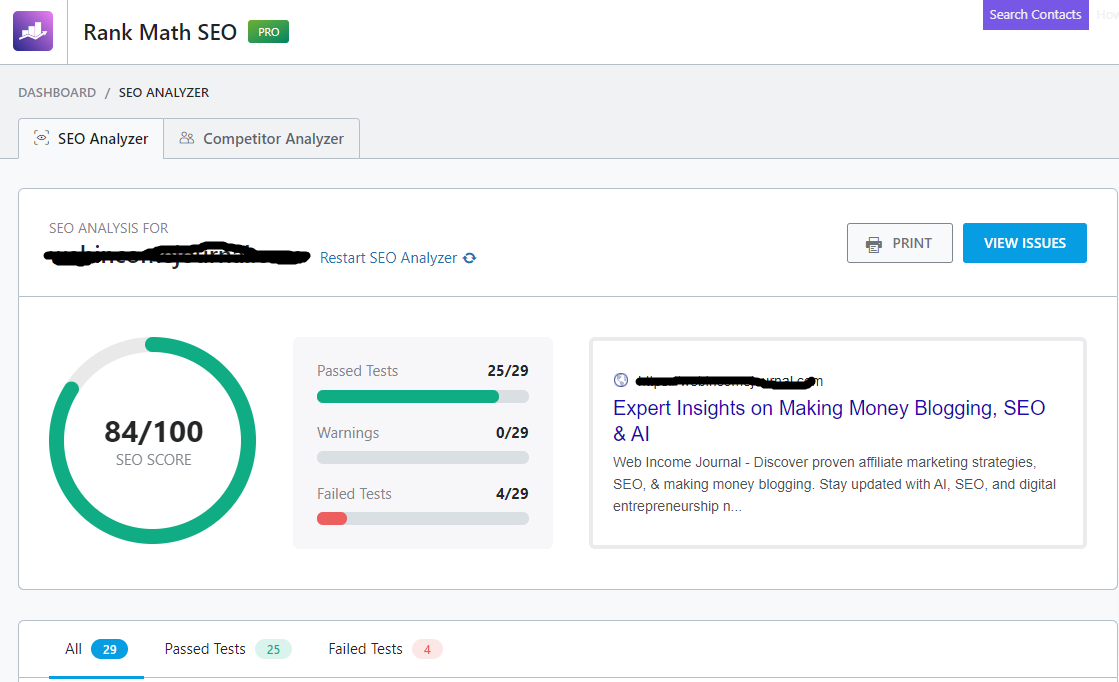
The audit report is organized into several categories (Priority, Basic SEO, Advanced SEO, Performance and Security). Within each category, you’ll find specific items listed and a brief explanation plus an indication of whether an item passed or failed the test.
Where an item failed the test, Rank Math also offers suggestions on how to resolve each issue, making it easier to take action.

Step 3: Identify Technical SEO Issues
With the website crawl and analysis complete, the next step is to carefully review the audit report generated by Rank Math and identify the specific technical SEO issues that need to be addressed. As we have mentioned earlier, you will need to pay attention to the following elements: robots.txt, XML sitemap, URL structure, images and media sizes, etc.
Step 4: Create Your Action Plan
Here’s how you can approach this process:
- Understand the Issues: For each identified issue, Rank Math provides a brief explanation to help you understand the underlying problem and its potential consequences. Take the time to thoroughly review these explanations to gain a better understanding of the technical SEO concepts involved.
- Leverage Rank Math’s Reporting: Rank Math’s comprehensive reporting makes it easy to navigate and explore the identified issues in greater detail. You can filter and sort the report based on various criteria, such as issue type, affected URLs, or specific pages and posts.
- Identify Patterns and Common Issues: As you review the report, keep an eye out for patterns or recurring issues that may indicate broader underlying problems. For example, if you notice multiple broken links or crawl errors, it could suggest an issue with your site’s architecture or URL structure.
- Document and Organize: Create a detailed action plan or checklist to document the identified issues, their priority levels, and any notes or steps required to resolve them. This will help you stay organized and ensure that no critical issues are overlooked during the remediation process.
- Prioritize Based on Impact: Once you have a clear understanding of the issues, prioritize them based on their potential impact on your site’s search engine visibility, user experience, and overall performance. Start by focusing on resolving any critical errors, as these are the most pressing issues that could significantly impact your site’s search engine performance.
At the end of your review, your technical SEO audit template or plan might look something like this:
| Issue ID | Issue Description | Severity Level | Affected Pages/URLs | Notes/Steps to Resolve | Priority Level |
| 001 | Broken Links | Error | /page1, /page2 | Check the URLs for typographical errors, update the links to the correct URLs, or remove the broken links altogether. | High |
| 002 | Missing Meta Descriptions | Warning | /page3, /blog-post1 | Add unique, descriptive meta descriptions to each affected page. Ensure they are within the recommended character limit. | Medium |
| 003 | Slow Page Load Speed | Error | /homepage, /product1 | Optimize images, leverage browser caching, and reduce server response times. Use tools like Google PageSpeed Insights for specific recommendations. | High |
| 004 | Duplicate Content | Error | /blog-post2, /blog-post3 | Use canonical tags to indicate the preferred version of the content or rewrite the content to be unique. | High |
| 005 | Missing Alt Text for Images | Warning | /blog-post4, /page4 | Add descriptive alt text to all images. Ensure the text accurately describes the image content for accessibility and SEO. | Medium |
| 006 | Crawl Errors | Error | /page5, /page6 | Investigate the cause of the crawl errors in Google Search Console, fix any server errors, and resubmit the affected URLs for crawling. | High |
| 007 | HTTPS Security Issues | Error | Entire Site | Ensure that all pages are served over HTTPS. Fix any mixed content issues by updating resources to be served securely. | High |
| 008 | XML Sitemap Issues | Notice | Sitemap.xml | Ensure the XML sitemap is up-to-date and includes all relevant URLs. Check for and resolve any errors reported in Google Search Console. | Low |
| 009 | Mobile Usability Issues | Warning | /homepage, /page7 | Make necessary adjustments to ensure that the site is mobile-friendly. Use Google’s Mobile-Friendly Test for specific suggestions. | Medium |
| 010 | Structured Data Errors | Warning | /product2, /blog-post5 | Review and correct the structured data markup. Use Google’s Structured Data Testing Tool to identify and fix errors. | Medium |
Step 5: Fix Identified Issues
Once you’ve identified the technical SEO issues plaguing your website, it’s time to take action and implement the necessary fixes. The good thing is that Rank Math provides actionable recommendations and intuitive tools to help you address each issue effectively, ensuring your website is optimized for search engine visibility and user experience. Here’s how:
- Broken Links and 404 Errors
Rank Math’s Redirection Manager allows you to easily set up 301 (permanent) or 302 (temporary) redirects to seamlessly redirect visitors and search engine crawlers to the correct pages. This powerful tool ensures that your site maintains a clean link structure, preventing dead ends and improving overall crawlability.
In the Redirection Manager (Rank Math > Redirections), simply enter the old (broken) URL and the new (working) URL to create a 301 permanent redirect.
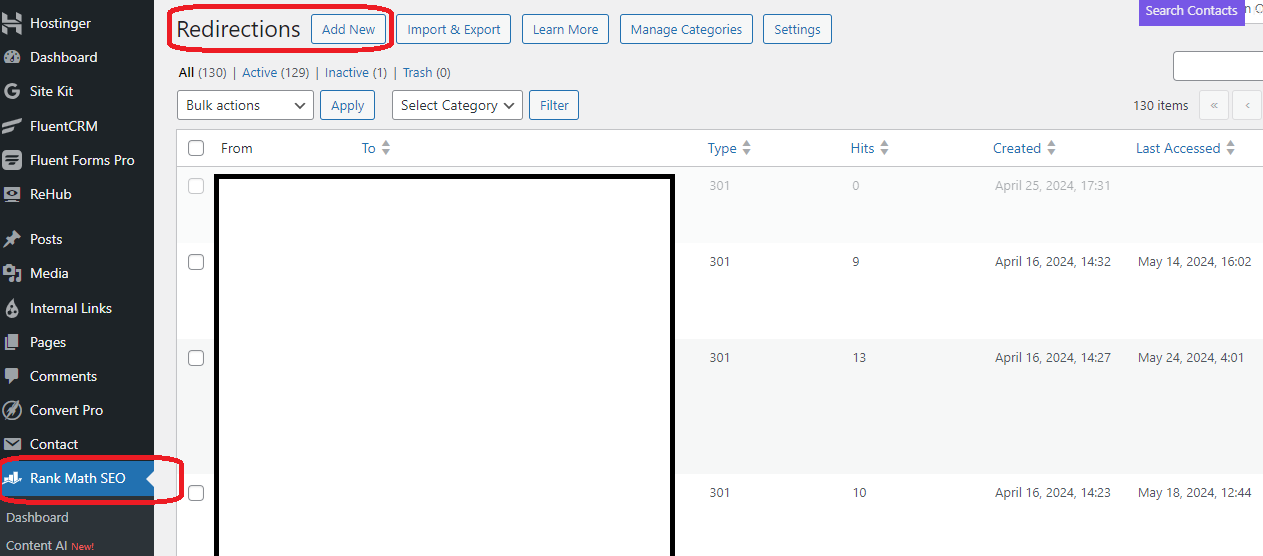
Beyond this, Rank Math will automatically monitor your redirects and alert you if any issues arise, allowing you to stay on top of your site’s link health.
2. Images and Media Files
If Rank Math’s analysis report highlights these issues, make sure Rank Math’s intuitive image optimization features are enabled. Rank Math also recommends using Imagify to compress and resize your images. This helps in reducing the files sizes without compromising quality.

3. Page Speed
As we mentioned earlier, slow-loading pages can drive users away and negatively impact your search rankings. If Rank Math identified pages with slow load times, you can easily correct this using the recommendations. This may involve leveraging caching mechanisms, minifying code, or optimizing resource-heavy elements like scripts and stylesheets.
4. XML Sitemap Errors
If the analysis report identifies any errors or issues with your existing sitemap, you can easily rectify them using Rank Math’s intuitive Robots.txt Editor. The Robots.txt Editor allows you to customize your XML sitemaps to include or exclude specific content types, adjust crawl frequencies, and prioritize important pages. The plugin provides clear guidelines and recommendations, ensuring that your configurations align with best practices and your website’s specific requirements.
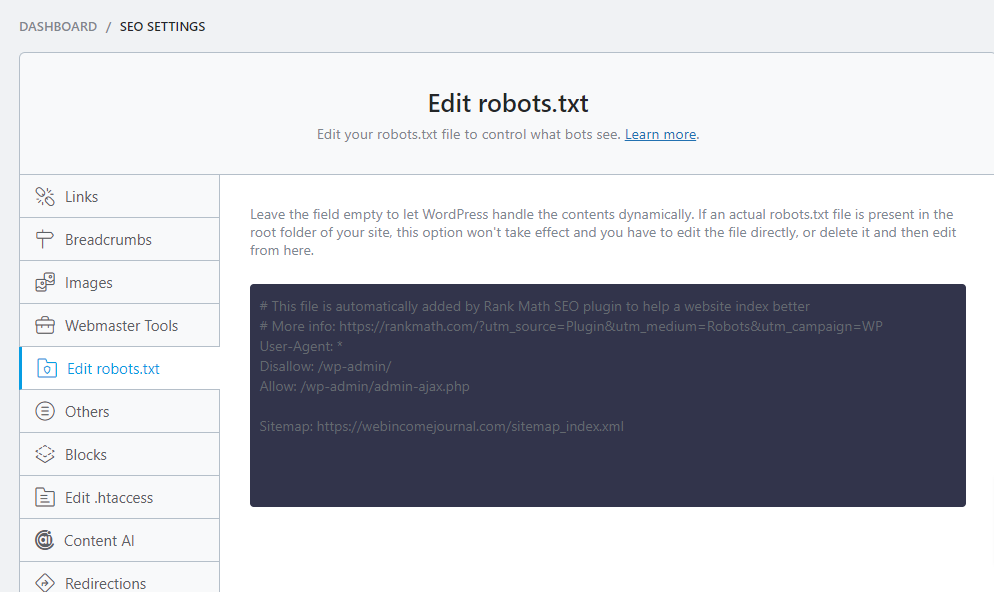
5. Meta Descriptions and Titles
Well-crafted meta descriptions and titles play a crucial role in improving click-through rates and search engine visibility. Rank Math’s analysis will highlight instances where these meta tags are missing, duplicated, or poorly optimized. Use Rank Math’s powerful meta optimization features (Rank Math > Titles & Meta), to craft compelling and SEO-friendly meta descriptions and titles for each page, ensuring that your content stands out in search results.
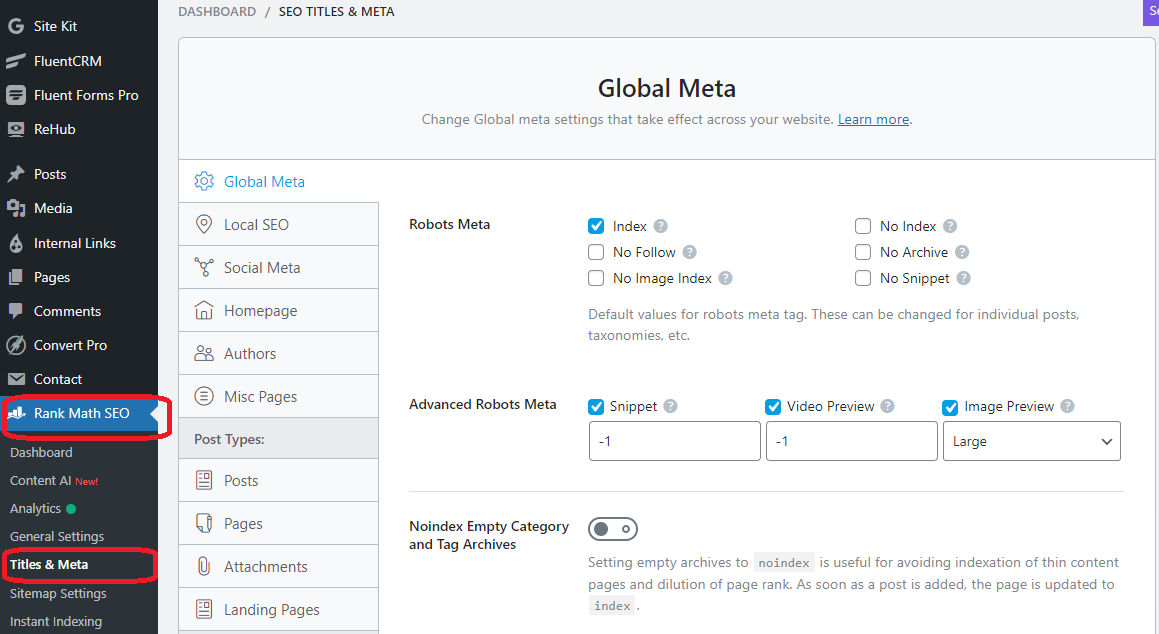
Besides, you can also use Rank Math’s powerful ContentAI to craft compelling and SEO-friendly meta descriptions and titles for each page, ensuring that your content stands out in search results.
Recommended: Optimizing for AI: How SEOs Can Win in the Gemini Era
Tips and Tricks for Maximizing Rank Math’s Potential
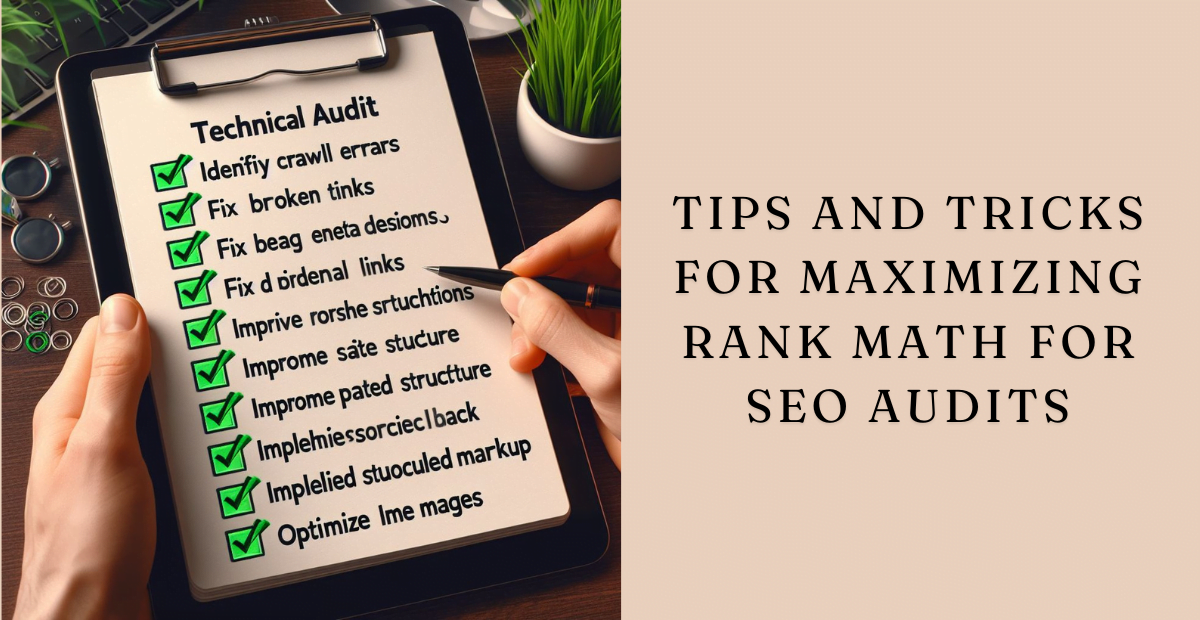
While Rank Math is a powerful tool for conducting SEO audits, some various tips and tricks can help you unlock its full potential and streamline your optimization efforts:
- Setup regular SEO performance reports
Monitoring your website’s SEO performance is crucial for identifying areas that require attention and tracking the effectiveness of your optimization efforts. With Rank Math, you can:
- Schedule Automated Reports: Set up automated weekly or monthly reports that provide detailed insights into your website’s technical SEO health, including crawl errors, broken links, and performance metrics.
- Customized Reporting: Tailor your reports to focus on specific areas of interest, such as page speed, mobile usability, or schema markup implementation, allowing you to prioritize your optimization efforts effectively.
2. Integrate external performance monitoring tools
While Rank Math offers robust technical SEO auditing capabilities, integrating external performance monitoring tools can provide additional insights and recommendations. For example:
- Google PageSpeed Insights: Utilize this tool to analyze your website’s page load times and receive actionable recommendations for improvement. Rank Math can help you implement these recommendations, enhancing your site’s speed and performance.
- Google Mobile-Friendly Test: Evaluate your website’s mobile-friendliness using this tool and leverage Rank Math’s optimization features to address any identified issues, ensuring a seamless mobile experience for your users.
3. Regularly update and submit your sitemaps
- XML sitemaps play a crucial role in helping search engines discover and index your website’s content effectively. With Rank Math, you can streamline this process by:
- Automated Sitemap Generation: Rank Math automatically generates and updates your XML sitemaps, ensuring they always reflect your website’s latest content and structure.
- Search Engine Submission: Easily submit your sitemaps to popular search engines like Google and Bing directly from the Rank Math interface, ensuring they have access to the most up-to-date information about your website.
4. Leverage Rank Math analytics to inform your SEO strategy
- Rank Math’s built-in analytics provide valuable insights into your website’s performance, allowing you to make data-driven decisions about your SEO strategy. Utilize these analytics to:
- Identify Top-Performing Content: Analyze which pages and content types are driving the most organic traffic, allowing you to double down on successful strategies and replicate them across your website.
- Identifying Trends and Patterns: By analyzing historical data, you can uncover trends and patterns in your website’s performance, allowing you to anticipate potential issues or capitalize on emerging opportunities.
- Prioritizing Optimizations: Rank Math’s detailed reports can help you prioritize your technical SEO efforts by highlighting the most pressing issues and areas with the greatest potential for improvement.
- Measuring Impact: After implementing technical SEO optimizations, Rank Math’s analytics can quantify the impact of your efforts, demonstrating the tangible benefits of your work and informing future decision-making.
- Aligning with Business Goals: By tying your technical SEO performance to key business metrics like organic traffic, conversions, and revenue, you can better align your efforts with overall organizational goals and demonstrate the value of your SEO initiatives.
Wrapping Up
Technical SEO audits may sound intimidating but they are crucial for identifying and resolving hidden issues that could be sabotaging your website’s search performance.
In this post I’ve walked you through how Rank Math can help you simplify the process. From crawling and indexing to advanced features like schema markup and rich snippets, Rank Math has got you covered. It will not only help you diagnose the SEO issues but also provide actionable insights to fix them.
Remember however, that technical SEO isn’t a one-and-done process. Your website is an ever-evolving entity, and search engines are constantly updating their algorithms. Staying on top of potential technical issues through regular audits using Rank Math will help ensure your site remains visible, crawlable, and ranking well.
If this post is of any help to you, we’ll appreciate it if you will help us share it with your online contacts. And, you can also share your thoughts with us in the comments below.
Frequently Asked Questions
-
What is a technical SEO audit?
It is a comprehensive analysis of a website’s technical elements that impact its search engine optimization and crawlability. It examines various factors such as website structure, coding, site speed, mobile-friendliness, and indexability to identify potential issues that could be hindering the website’s visibility and ranking in search engines.
-
How long does a technical SEO audit take?
The duration can vary depending on the size and complexity of the website. For smaller websites, it may take a few hours to a day, while larger, more complex websites can take several days or even weeks to complete a thorough audit.
-
Is technical SEO difficult?
Technical SEO can be challenging, especially for those new to the field or without a technical background. It involves understanding various coding languages, website technologies, and search engine algorithms. However, with the right tools, resources, and guidance, it becomes more manageable and can significantly improve a website’s search performance.
-
What is the difference between SEO and an SEO audit?
SEO (Search Engine Optimization) refers to the ongoing process of optimizing a website to improve its visibility and ranking in search engine results pages (SERPs). It involves various on-page, off-page, and technical strategies.
An SEO audit, on the other hand, is a comprehensive analysis and assessment of a website’s current SEO performance and identifies areas for improvement. It serves as a starting point for developing and implementing an effective SEO strategy.




This guide to conducting a technical SEO audit with Rank Math is top-notch! It’s packed with practical steps, insights, and comparisons with other tools, making it a must-read for improving website performance.
This post is a fantastic resource for anyone looking to enhance their website’s performance! I appreciate how you’ve simplified the technical SEO audit process using Rank Math into just five steps. The tips and insights provided will definitely help both beginners and seasoned pros improve their site’s visibility. Thanks for sharing such practical guidance!